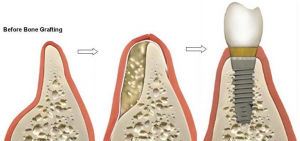 Sometimes in order to maximize the effectiveness of certain dental procedures, other procedures must be done first. Such is the case with bone grafting. Bone grafting is sometimes performed before dental implants because it helps better prepare the area where the implant’s going to be and lends to the probability of the overall dental implant proceeding being a success.
Sometimes in order to maximize the effectiveness of certain dental procedures, other procedures must be done first. Such is the case with bone grafting. Bone grafting is sometimes performed before dental implants because it helps better prepare the area where the implant’s going to be and lends to the probability of the overall dental implant proceeding being a success.
What Is a Bone Graft?
A bone graft is a procedure in which missing bone is replaced. It is commonly used in order to repair bone fractures that are extremely complex, and in dentistry, it’s commonly used before dental implant procedures. Additionally, bone grafts can be used on injuries that pose a significant health risk to patients if they’re left as is and when fractures fail to heal properly.
Traditional Bone Grafting
The process of bone grafting first began back in the 1970s and 80s, but back then the process was not near as advanced as it is today. Back then, bone grafting procedures focused on building a stable base for dentures by using portions of a patient’s ribs, thighs or other tissue to fashion a new hoop for the jaw to support the teeth. Nowadays, bone grafting procedures aren’t done in such extensive measures, in most cases.
Bone Grafting and Dental Implants
 Nowadays, most bone grafting procedures are minimally invasive ones that don’t require the extensive surgery that traditional bone grafting treatments did. Perhaps the major difference between traditional bone grafting procedures and the ones that are used today is that the bone used in grafting procedures is no longer harvested from the patient’s own body. Rather, it is usually obtained from bone that has already been pre-harvested from animals for such purposes. The most common type of bone graft used nowadays is that of bovine bone that has been completely sterilized, is comprised only of the mineral content of the bone and has had all the organic material removed from it. By using such bone grafts, the tissues surrounding the jaw bone are prevented from collapsing, and the body is essentially tricked into recognizing the graft as its own natural bone, which causes the body to reabsorb and replace it with natural bone, providing a solid structure for dental implants.
Nowadays, most bone grafting procedures are minimally invasive ones that don’t require the extensive surgery that traditional bone grafting treatments did. Perhaps the major difference between traditional bone grafting procedures and the ones that are used today is that the bone used in grafting procedures is no longer harvested from the patient’s own body. Rather, it is usually obtained from bone that has already been pre-harvested from animals for such purposes. The most common type of bone graft used nowadays is that of bovine bone that has been completely sterilized, is comprised only of the mineral content of the bone and has had all the organic material removed from it. By using such bone grafts, the tissues surrounding the jaw bone are prevented from collapsing, and the body is essentially tricked into recognizing the graft as its own natural bone, which causes the body to reabsorb and replace it with natural bone, providing a solid structure for dental implants.
Types of Bone Grafts
Most of the types of bone grafts used nowadays are outpatient procedures. It’s not uncommon for dentists to discuss one of these options with their patients when they’re considering dental implants as an option to hold the space where the implant will go open during the healing period allotted between the pulling of the tooth and the placing of the implant.
Socket Grafts
Socket grafts, more technically known as alveolar ridge preservation grafts are ones that are designed to fill the void that’s left behind after tooth extraction when an implant can’t immediately be put in place. In most cases, implants can’t be placed directly after tooth extraction, which necessitates the need for socket grafts to hold the socket areas open for the placement of the implants later on. The graft not only holds open the needed space, but it also provides the body with a chance to proliferate and fill the space with a healthy, new bone again to provide ample support for the dental implant.
Block Bone Grafts
The block bone graft, also known as the chin graft or the autogenous ramus graft, is the type of graft that does consist of harvesting the patient’s own natural bone. It is mostly used when the bone provided by a bovine won’t be able to adequately replace what was lost. Situations where bone loss might be significant enough to warrant this type of graft include when teeth were extracted without immediate socket grafts being placed, when teeth are missing and the disease associated with the missing tooth caused significant bone destruction and when there is bone loss due to dental trauma.
References:
American College of Prosthodontists. “Answers to common questions about prosthodontics and smile restoration.” Retrieved on Nov. 12, 2015 from http://www.gotoapro.org/faqs/.
American Association of Oral and Maxillofacial Surgeons. “Dental implants.” Retrieved on Nov. 11, 2015 from http://www.aaoms.org/dental_implants.php
American College of Prosthodontists
211 E Chicago Ave # 1000
Chicago, IL 60611
(312) 573-1260
www.prosthodontics.org
American Association of Oral and Maxillofacial Surgeons
9700 West Bryn Mawr Avenue
Rosemont, Illinois 60018-5701
847-678-6200 / 800-822-6637
www.aaoms.org
Images:
https://farm9.staticflickr.com/8593/15986847741_afa6c04f9c.jpg